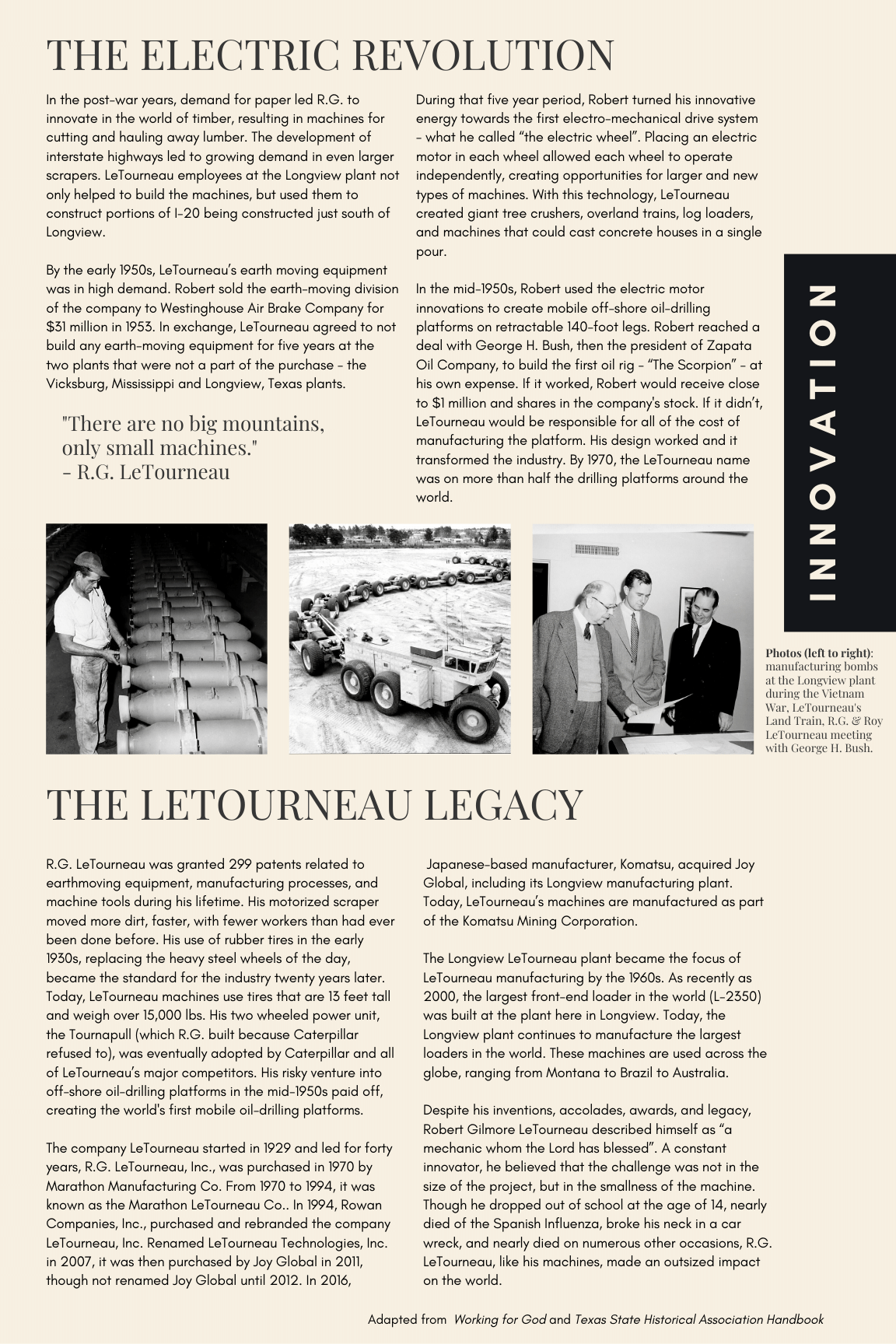The Electric Revolution
In the post-war years, demand for paper led R.G. to innovate in the world of timber, resulting in machines for cutting and hauling away lumber. The development of interstate highways led to growing demand in even larger scrapers. LeTourneau employees at the Longview plant not only helped to build the machines, but used them to construct portions of I-20 being constructed just south of Longview.
By the early 1950s, LeTourneau’s earth moving equipment was in high demand. Robert sold the earth-moving division of the company to Westinghouse Air Brake Company for $31 million in 1953. In exchange, LeTourneau agreed to not build any earth-moving equipment for five years at the two plants that were not a part of the purchase - the Vicksburg, Mississippi and Longview, Texas plants.
During that five year period, Robert turned his innovative energy towards the first electro-mechanical drive system - what he called “the electric wheel”. Placing an electric motor in each wheel allowed each wheel to operate independently, creating opportunities for larger and new types of machines. With this technology, LeTourneau created giant tree crushers, overland trains, log loaders, and machines that could cast concrete houses in a single pour.
In the mid-1950s, Robert used the electric motor innovations to create mobile off-shore oil-drilling platforms on retractable 140-foot legs. Robert reached a deal with George H. Bush, then the president of Zapata Oil Company, to build the first oil rig - “The Scorpion” - at his own expense. If it worked, Robert would receive close to $1 million and shares in the company's stock. If it didn’t, LeTourneau would be responsible for all of the cost of manufacturing the platform. His design worked and it transformed the industry. By 1970, the LeTourneau name was on more than half the drilling platforms around the world.
The LeTourneau Legacy
R.G. LeTourneau was granted 299 patents related to earthmoving equipment, manufacturing processes, and machine tools during his lifetime. His motorized scraper moved more dirt, faster, with fewer workers than had ever been done before. His use of rubber tires in the early 1930s, replacing the heavy steel wheels of the day, became the standard for the industry twenty years later. Today, LeTourneau machines use tires that are 13 feet tall and weigh over 15,000 lbs. His two wheeled power unit, the Tournapull (which R.G. built because Caterpillar refused to), was eventually adopted by Caterpillar and all of LeTourneau’s major competitors. His risky venture into off-shore oil-drilling platforms in the mid-1950s paid off, creating the world's first mobile oil-drilling platforms.
The company LeTourneau started in 1929 and led for forty years, R.G. LeTourneau, Inc., was purchased in 1970 by Marathon Manufacturing Co. From 1970 to 1994, it was known as the Marathon LeTourneau Co.. In 1994, Rowan Companies, Inc., purchased and rebranded the company LeTourneau, Inc. Renamed LeTourneau Technologies, Inc. in 2007, it was then purchased by Joy Global in 2011, though not renamed Joy Global until 2012. In 2016, Japanese-based manufacturer, Komatsu, acquired Joy Global, including its Longview manufacturing plant. Today, LeTourneau’s machines are manufactured as part of the Komatsu Mining Corporation.
The Longview LeTourneau plant became the focus of LeTourneau manufacturing by the 1960s. As recently as 2000, the largest front-end loader in the world (L-2350) was built at the plant here in Longview. Today, the Longview plant continues to manufacture the largest loaders in the world. These machines are used across the globe, ranging from Montana to Brazil to Australia.
There are no big mountains, just small machines.
Despite his inventions, accolades, awards, and legacy, Robert Gilmore LeTourneau described himself as “a mechanic whom the Lord has blessed”. A constant innovator, he believed that the challenge was not in the size of the project, but in the smallness of the machine. Though he dropped out of school at the age of 14, nearly died of the Spanish Influenza, broke his neck in a car wreck, and nearly died on numerous other occasions, R.G. LeTourneau, like his machines, made an outsized impact on the world.
(Adapted from Peel, Working for God and Texas Historical Association Online Handbook.)
